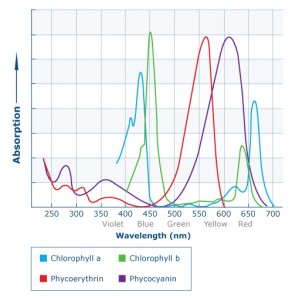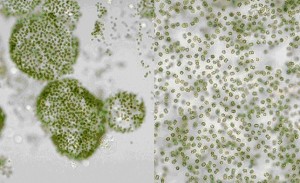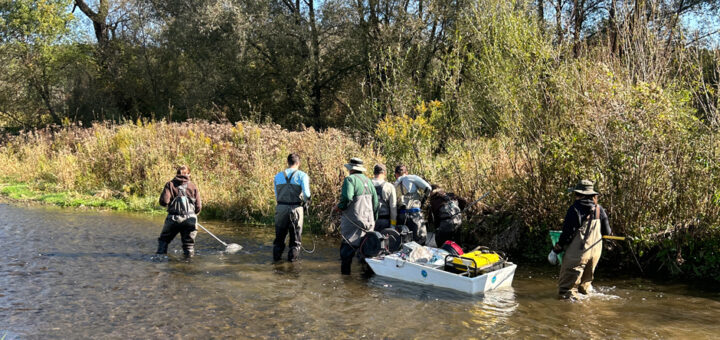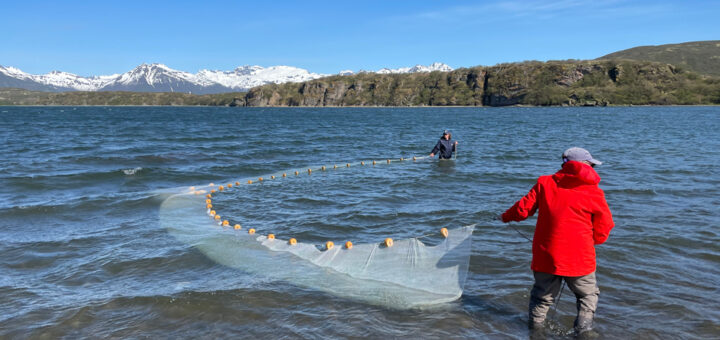Biological Sensors
Kevin Rose | Smithsonian Environmental Research Center (biological sensors)
What is a biological sensor?
Biological sensors measure the presence, movement and number of organisms in lakes and other freshwaters, providing important information on the health and safety of aquatic ecosystems. For example, some organisms such as blue-green algae (also known as cyanobacteria) can produce harmful algal blooms which can be toxic to aquatic organisms and humans; these can be measured with a phycocyanin sensor.
Because of the complexity of biological measurements, most are usually done in-lab. However, this approach can be slow, expensive and makes it difficult to understand rapid changes in lake water quality. A number of sensors exist which can be used to measure biological characteristics in water and in real-time.
What can biological sensors measure?
There are few biological sensors relative to physical or chemical sensors. Some of the most common biological sensors for lakes and other freshwaters include:
- Chlorophyll
- Blue-green algae/Cyanobacteria (Phycocyanin/Phycoerythrin)
- Fish Finders
- Pathogens
Chlorophyll

Fluorescence is used to identify chlorophyll, phycocyanin, and phycoerythrin. These compounds absorb light at specific wavelengths and reemit light at specific longer wavelengths in a process called fluorescence. (Image adapted from NSW Department of Commerce)
Chlorophyll is a green pigment found in plants, algae, and cyanobacteria used in photosynthesis, the process plants use to produce energy from sunlight. The amount of chlorophyll in a lake reflects the concentration of algae or phytoplankton, which is related to overall water quality. Chlorophyll can take several slightly different forms (e.g. chlorophyll a vs. chlorophyll b), but often sensors do not distinguish between different forms.
Chlorophyll in water can be measured using fluorescence. Fluorescence occurs when a material absorbs light from a source with a higher energy level and emits light of a lower energy level (or longer wavelength). Fluorescence is analogous to a biological material’s fingerprint because every material or compound emits a specific fluorescence signature. Other methods of detecting biological life include echo sounding and adding a chemical to a water sample to cause a reaction.
Chlorophyll sensors can be sensitive to outside interference. Bright light causes algal cells to protect themselves so chlorophyll sensors read artificially low chlorophyll measurements. Other factors such as variation in temperature and water color can also affect sensor accuracy.
Cyanobacteria/Blue-green algae (Phycocyanin/Phycoerythrin)
Cyanobacteria, also known as blue-green algae, are a group of bacteria that obtain their energy through photosynthesis, similar to plants. Besides chlorophyll, cyanobacteria also have other pigments that fluorescence can detect.
Cyanobacteria are known for their important role in noxious surface scums, known as harmful algal blooms, that form on lakes and ponds around the world. Cyanobacteria can produce toxins which can be harmful to other aquatic organisms and humans.

Microcystis, a common species of cyanobacteria, can form harmful algal blooms and produce toxins that are harmful to other aquatic organisms as well as humans. Phycocyanin sensors can be used to detect the presence of cyanobacteria in freshwaters. (Image from Botanical Gardens Trust)
Cyanobacteria often contain pigments such as phycocyanin (common in freshwater) or phycoerythrin (common in salt water). Fluorescence sensors are used to measure the concentration of phycocyanin or phycoerythrin. Phycocyanin absorbs red and orange light about 620 nm and it fluoresces at about 650 nm3. Phycoerythrin absorbs light in 495 and 545-566 nm and fluoresces at 575 nm4.
There are sensors specific to either measuring phycocyanin or phycoerythrin; for example the YSI 6131 measures phycocyanin while the YSI 6132 measures phycoerythrin. Several other companies such as Turner Designs also make cyanobacteria sensors for both freshwater and saltwater. Sensors usually measure these pigments in units of cells per milliliter5.
Fish Finders
Fish finders use SONAR to locate fish and water depth. A transducer converts electrical pulses to a sound wave which is emitted into the water. The sound wave is reflected back from the fish or the lake bottom to the sensor, amplifying a signal that the fishfinder displays.
In addition to SONAR, fish can be tagged and tracked via radio telemetry in a fashion similar to how animals can be tracked with radio collars or microchips.
Pathogens
Pathogens such as bacteria and viruses can enter the water stream via animal or human waste directly or through pollution sources. Despite the health risks of exposure, lab tests often take several days to produce results. Samples must be collected, a broth added to the sample, and samples must then be incubated for about 48 hours. A sample color change indicates the presence of coliforms and fluorescence in the long wavelengths detects presence of E.coli. New techniques using liquid crystal materials are currently being experimented on to improve the speed of pathogen detection.
Sources:
- Wikipedia. Phycocyanin Retrieved online March, 2010 from http://en.wikipedia.org/wiki/Phycocyanin
- Wikipedia Phycoerythrin (n.d.) In Wikipedia. Retrieved online March, 2010 from http://en.wikipedia.org/wiki/Phycoerythrin
- YSI 6131 and 6132 Blue-Green Algae Sensors (2006). Retrieved online March, 2010 from: https://www.fondriest.com/ysi-6131-bga-sensor.htm
- The SondeCAM submersible cameras are a rugged set of underwater eyes for anglers and researchers (2014) Retrieved online September, 2022 from: https://magazine.fishsens.com/sondecam-submersible-cameras
- Hach MEL/850 Potable Water Laboratory Manual. (1998) Retrieved online March, 2010 from http://www.fondriest.com/pdf/hach_2688800_manual.pdf
- Acharya, B.R. (2007, November 26) Unconventional Applications of Nematic Liquid Crystals: Polarization Management and Virus Detection; Presentation, Liquid Crystal Institute at Kent State University.
- Shiyanovskii, S.V., Schneider, T., Smalyukh, I.I., Ishikawa, T., Niehaus, G.D., Doane, K.J., Woolverton, C.J., Lavrentovich, O.D. (2005) Real-time microbe detection based on director distortions around growing immune complexes in lyotropic chromonic liquid crystals. Physics Review E, 71, 020702.









